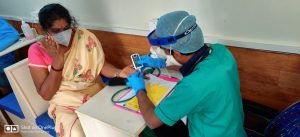India is battling a second wave of coronavirus infections, which could turn out to be more deadly than the first.
Since early March the country has witnessed a surge in COVID-19 infections. Daily coronavirus infections have risen for 19 days in a row. According to data released by India’s Ministry of Health and Family Welfare on March 29, there were 68,020 new cases over the preceding 24 hours, the highest single-day rise since October 11 last year. With this the total tally of COVID-19 cases in the country has crossed the 12-million mark. As for fatalities, 291 people died over a span of 24 hours, bringing the total number killed by the novel coronavirus so far in India to 161,843 people.
The number of new cases is growing at a faster pace in the second wave.
During the first wave, it took India 32 days to rise from 18,000 to 50,000 cases per day. This time around it took just 17 days for the cases to rise from 18,377 on March 11 to 50,518 on March 27. During the second wave, daily cases in Mumbai, among the worst hit cities, have risen from 850 to 2,100 in 24 days. It took the city 30 days for a similar rise during the first wave.
The number of daily new infections peaked at nearly 98,000 cases on September 16. Although crowds were thronging markets during a string of festivals and election rallies in several states in the months that followed, new infections began declining steadily thereafter.
In the first week of November, a glimmer of hope emerged. Although the daily caseload was around 47,000 cases and the total active cases at that point was 500,000, the R0 (or R-naught) — which is a measure of how many healthy people an infected person can spread the disease to or how contagious the disease is — dropped to 0.88 on November 6. This was a turning point as an R-naught value of less than 1 indicates that the virus is going to stop spreading.
With R-naught figures falling below 1, it did seem that the worst was over and although the possibility of fresh waves was never ruled out, succeeding waves were expected to be brief and with lower peaks than in September.
Then the R-naught value began rising again. It is currently 1.32. It is the highest since the week of March 27-April 6 last year when it was 1.83.
Virologists fear that at the pace at which infections are surging, the possibility of the second wave surpassing the September peak in the coming week cannot be ruled out.
The second wave is showing a high concentration of cases in a few states; 84 percent of the new infections have come from eight states, with Maharashtra (40,414 new cases) followed by Karnataka (3,082) leading the pack. Since the outbreak of the pandemic Maharashtra has contributed the maximum cases on most days but its daily share did not exceed 40 percent during the first wave. In recent weeks, the state has been contributing to over 60 percent of daily new infections.
Amid all the bleak statistics coming out of India’s fight against COVID-19, there are some figures that provide reason for a bit of optimism. India appears to have been successful in keeping down fatalities. Not only has its case fatality ratio (CFR) been low compared to other countries but also, this figure continues to decline. It fell from 1.75 percent in July 2020 to 1.4 percent in December, 0.79 percent in February. Its average CFR in the March 1-15 period this year has been 0.59 percent.
Additionally, although the second wave is gathering pace faster than last year, India is better prepared to tackle with it. Unlike last year, when it had to build from scratch its health infrastructure to fight the pandemic, this time around it seems better prepared.
Besides, the country now has vaccines to fight the spread. So far India has vaccinated 60 million people, including health and other frontline workers, the elderly (above 60 years of age) and those above 45 years with co-morbidities. However, the process so far has been slow. Glitches in the registration system, shortage of vaccines in some states as well as public skepticism over the value of vaccinations have slowed the roll-out. It is expected to pick up momentum from April 1, when vaccinations will be available to all people above 45 years of age.
The second wave in infections and the expansion of the domestic vaccination drive has implications for the world’s fight against the pandemic. It will slow the vaccination drive of many countries that are receiving vaccine from India.
Since January 20, India has supplied over 60 million doses of vaccines to around 75 countries. This supply will reduce over the coming months. It has decided “to calibrate [vaccine] supply schedules” to other countries based on its own domestic requirements. The government has stressed that supplies are not being halted or suspended but only delayed. Officials have clarified that the government has not imposed a ban on exports and that it “is a temporary move until the supply situation stabilizes in the country.”
While greater domestic availability of vaccines will improve India’s effort to fight the second wave, vaccination by itself will not be enough to keep the number of infections under check.
People are not wearing masks or obeying social distancing norms. A recent survey shows that although 90 percent of Indians are aware of the need to wear a mask, only 44 percent are doing so.
Several states are voting in state assembly elections in April and May. Not wearing masks is the norm at most election rallies. Doctors are calling for mask wearing to be made compulsory at these crowded events. But it is election time and politicians are keen to avoid ruffling the feathers of voters by issuing orders to this effect.
































